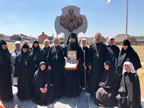
DIOCESE OF GREAT BRITAIN: July 9, 2018
London: A monument to the Royal Family is consecrated on the Isle of Wight
 In advance of the 100th anniversary of the martyrdom of the Holy Royal Martyrs, a major event marking the centenary took place this weekend on the Isle of Wight, off the southern coast of England. The weekend was dedicated to the honor of the Royal Martyrs, with its focal point the unveiling of a seven-ton granite Cross on which a bronze-relief of the Royal Martyrs is surmounted above their memorial. In advance of the 100th anniversary of the martyrdom of the Holy Royal Martyrs, a major event marking the centenary took place this weekend on the Isle of Wight, off the southern coast of England. The weekend was dedicated to the honor of the Royal Martyrs, with its focal point the unveiling of a seven-ton granite Cross on which a bronze-relief of the Royal Martyrs is surmounted above their memorial.
The liturgical elements of the weekend — including the celebration of the Divine Liturgy on Saturday and Sunday and evening services on Saturday, as well as the dedication and blessing of the monument itself — were undertaken by clerics of the Russian Orthodox Church Outside of Russia, led by His Grace Bishop Irenei of Sacramento, Administrator of the Diocese of Great Britain and Ireland, together with Archpriest Andrew Phillips of the Parish of St John the Wonderworker in Colchester, England, and Mitred Archpriest Michael Protopopov of the Diocese of Australia and New Zealand, who had traveled to Great Britain for the event.
The Holy Royal Martyrs, who were closely related to the British Royal Family, visited the Isle of Wight in 1909 as guests of King Edward VII. A famous portrait taken on the grounds of Barton Manor and Osborne House, which had been the summer home of Queen Victoria, memorializes the days spent there, which were a source of refreshment and joy to both Royal Families.
Over 300 people, including many local residents of the Isle of Wight as well as pilgrims from other parts of England and Scotland, Russia, Australia, America, France, Germany, Belarus and further afield, attended the unveiling of the new memorial. Remarks were given by the Queen’s Lord Lieutenant, the Mayor of East Cowes on the Isle of Wight, the representative of the Russian Ambassador to Great Britain, members of the Town and County Councils and of the Romanov family, as well as members of the Grand Duchess Elizabeth Society, based in the United Kingdom, which was the principal organizer of the event.
In his remarks at the unveiling, prior to serving a moleben to the Holy Royal Martyrs and blessing the new monument with holy water, Bishop Irenei reminded the assembled guests that they were honoring not just a group of significant political figures of twentieth-century history, nor yet simply individuals who figured in a unique way into the local history of the Isle of Wight, but indeed a family of martyrs who bore witness in their lives, and in their deaths, to the God Whose love never fails, and Who is ultimately the true King over all kings, to Whom pious kings and royalty — such as the Tsar-Martyr and his family — gladly give full glory, even if it costs them their earthly lives.
At the end of the dedication ceremony, the Royal Standard of the Russian Empire flew on a flagpole alongside the Union Flag, the first time these Standards had flown side by side on the island since the Royal Martyrs had stood on the same ground; and the Russian Imperial National Anthem (“God save the Tsar”) was sung together with the British National Anthem (“God save the Queen”) — once again, the first time that the Royal national Anthem of the Tsar had been sung in ceremony here since St Nicholas and his family had heard it in their presence more than a century before. This proved an especially moving moment in a day filled with holiness and reverence.
Throughout the weekend, the Divine Services celebrated by Bishop Irenei together with the assembled clergy, were sung by a choir of nuns from St Elizabeth Convent in Minsk. Relics of the Holy Royal Martyr the Grand Duchess Elizabeth, together with her co-sufferer the Martyr Barbara, were brought for the occasion with the blessing of His Eminence Archbishop Mark of Berlin and Germany, carried by Abbess Maria of the Convent of St Elizabeth in Buchendorf, Germany. The grounds of Barton Manor, where the Royal Martyrs had stayed (now a private residence) were opened to the participants of the events, and a special exhibition of rare memorabilia connected to the lives of the Royal Martyrs made available to the community at large, accompanied by a series of talks on the significance of the Royal Martyrs and of their time spent in the United Kingdom.
The event attracted significant public attention, including reporting from the BBC (https://www.bbc.com/news/uk-england-hampshire-44756796) and other news media; but more significant than the public attention was the fact that here, on an island where the Holy Royal Martyrs had enjoyed the company of family and the idyllic retreat of beautiful scenery, the culture of a century later deemed it fitting and proper to gather in their honor, to recognize their martyric sacrifice and the place it holds in the faith and history of our modern world, and to rediscover the strong connections that existed between Imperial Russia and other regions of the world.
Holy Royal Martyrs, pray to God for us!

|